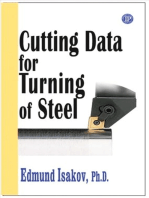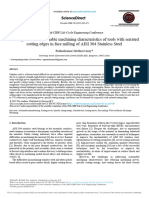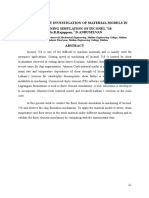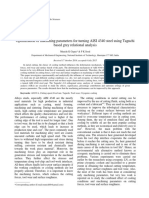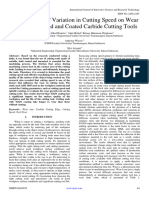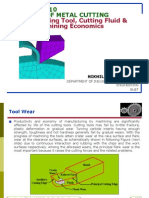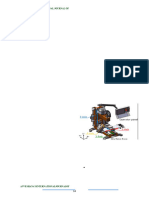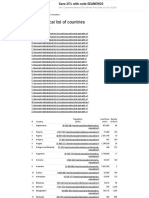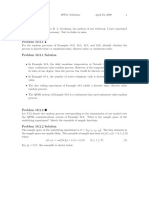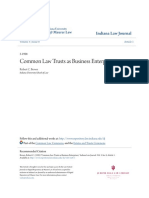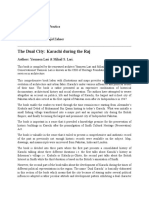Ijresm V5 I4 21
Ijresm V5 I4 21
Uploaded by
murat aydoganCopyright:
Available Formats
Ijresm V5 I4 21
Ijresm V5 I4 21
Uploaded by
murat aydoganOriginal Title
Copyright
Available Formats
Share this document
Did you find this document useful?
Is this content inappropriate?
Copyright:
Available Formats
Ijresm V5 I4 21
Ijresm V5 I4 21
Uploaded by
murat aydoganCopyright:
Available Formats
International Journal of Research in Engineering, Science and Management 76
Volume 5, Issue 4, April 2022
https://www.ijresm.com | ISSN (Online): 2581-5792
Design and Development of Milling Cutter Tool
Aashu Gupta1*, Ananaya Singh2, Ashok Kumar Madan3
1,2
Student, Department of Mechanical Engineering, Delhi Technological University, Delhi, India
3
Professor, Department of Mechanical Engineering, Delhi Technological University, Delhi, India
Abstract: When we analyze an end cutting tool statically, we insert in the research, is a good example of a high-speed steel
must take into account a variety of factors such as heat to machine mold. The following are some of its characteristics:
distribution, cutting force and torque applied to the tool, wear, and
1. At room temperature, it has a tensile strength of 1044
vibration. The goal is to design and analyze a milling cutting tool.
SolidWorks-21 was used to design the cutting tool, which in this Mpa.
case was an end mill tool, as well as to do the static analysis. The 2. Hardness ranges between 280 and 320 HB.
external loadings are as follows: The end mill cutting surface is With increasing cutting speed, feed rate, axial depth, and
subjected to torque of 26 N/m. One of the tool surfaces is subjected radial depth of cut, tool life diminishes. The chemical
to 1250 N of force. After running the simulation in SolidWorks – composition of the carbide coated tool has an impact on its wear
21, the lowest FOS and maximum resulting displacement were 12
rate. When constructing a milling cutting tool, there are three
and 0.0969mm, respectively. It is evident from the preceding result
that the tool is less likely to break. key elements to consider during the machining process, the
temperature distribution was monitored, Torque generated ,the
Keywords: Cutting force, vibration, end mill tool, static analysis, amount of cutting force applied to the tool and Cutting force
loadings. exerted on the tool.
This is critical in order to avoid tool failure. The temperature
1. Introduction in the cutting zone at the tool-chip interface can reach 1000
In the milling process, the chip bearing process occurs due to degree C during machining. The torque recorded when
lateral plastic flow of material that forms burr at the edge of the workpiece material stainless steel AISI 618 is end-milled with
shear zone. The performance of a cutting tool affected by three carbide inserts PVD coated with a layer of TiN is listed in Table
factors that play the important role: 1. Because 23Nm is the maximum result from Table 1, we
1. Hardness conclude that the tools must be able to tolerate a torque of 23Nm
2. Wear resistance in order to avoid tool failure.
3. Chemical inertness Table 2 displays the cutting force, and we can see that the
4. Fracture toughness of the workpiece material. tools must be able to bear forces more than 1250N in order to
Because of the combination of high temperature, high avoid tool failure. This is proven by Kadirgama's experiment
workpiece strength, work hardening, and abrasive chips, with Hastelloy C-22HS as a workpiece material. According to
notching at the tool nose and depth of cutting region was a Fuh and Hwang's experiment, when a 20mm helix angle is
common failure mode when machining nickel-based alloys. utilized and a 30o helix angle is employed, the maximum
Special physical circumstances, such as stress and high milling force is 722.7N. The forces acting on the tool in the
temperatures, are the most typical causes of tool wear. orthogonal cutting method, according to Dombovari and
It is critical to keep track of tool life in order to avoid losing Stepan, can be illustrated as shown in Figure 2, where the shear
time on tool replacement and resetting the tool during force, Fs, and normal force, Fn are as follows:
machining.
Carbide tips type cutting tool usually suffers flank wear as
shown in figure below.
Fig. 2. Forces acting on a tool in 2D cutting
Fig. 1.
The AISI P20, which was milled utilizing a carbide coated
*Corresponding author: aashuiitian@gmail.com
A. Gupta et al. International Journal of Research in Engineering, Science and Management, VOL. 5, NO. 4, APRIL 2022 77
Table 1 half of all tool damage cases, and they are caused by thermal
Experimental torque measured
fissures in the straight cutting edge.
Properties of high precision parts are improved by cold
treating them to temperatures ranging from -125 to -196 degrees
Celsius to increase hardness and improve hardness
homogeneity. The cryogenic treatment is what it's called.
Unlike coating, this ensures that the tools will retain their
quality following regrinding or resharpening. H13 tool steel
samples that were deep cryogenically treated increased the wear
characteristics of the steel by producing homogenous and very
tiny carbide particles.
2. Methodology
Using Marrow correction and fatigue analysis on the cutting
tool, an integrated Finite Element (FE) based analysis assists us
in producing optimal tool material. Under the set cutting
parameter, it can forecast deformation, stresses, and strain in the
workpiece, as well as the load on the tool. Techniques based on
the Finite Element Method (FEM) can provide more detailed
information on not just cutting forces but also tool stresses and
Table 2
temperatures. When employing a fresh cutter, the static cutting
Experimental cutting force (Kadirgama) force increases as the axial depth of cut increases. The attempt
made in this project design and development is to employ
cryogenic treated H13 tool steel as the material for the end mill
because it may give a uniform material hardness distribution
when compared to coated tools, which is ideal for resharpening
and regrinding. SolidWorks-19 is used to model the end cutting
tool in as much detail as feasible. Figure 3 shows the planned
H13 tool steel end mill.
Knowing the resultant forces is not enough to model a tool
during design; knowledge of the forces involved is required to
design a tool that can withstand the relevant forces.
Solid and coated carbide also have a higher hardness than
high-speed tool steels, allowing for faster cutting speeds and
material removal rates (HSS). The rake angle of the tool has an
impact on the friction and contact zone between the chip and
the tool. We discovered that as the radial rake angle increased,
the side burr thickness decreased linearly. When the radial rake Fig. 3. 3D modeling of a 25mm diameter and 180mm long end mill
generated by using Photo View 360 in SolidWorks-19
angle was between -30 and 30 degrees, however, it was
practically constant.Wear processes between the workpiece and
the cutting edge are important because they influence tool 3. Static Analysis
material selection for high-speed cutting. Static analysis was done on the intended end mill to estimate
To increase tool life, coating carbide tools was first created the likelihood of the tool breaking or failing under static
using the Chemical Vapor Deposition (CVD) technology, and loading. SolidWorks 2021 Simulation was used to do the finite
most multi-layer coating materials contained a combination of element analysis. According to the literature reviewed, which
TiC, TiN, Ti(N,C), and Al2O3 with varied deposition included books and research articles included in the references,
sequences.TiC coatings provide for great flank wear resistance, the maximum force and torque exerted on the tool throughout
whereas TiN coatings allow for negligible crater wear. A12O3 the cutting operation were considered. External loads were
or ALON, on the other hand, remain chemically stable even at applied to one of the tool surfaces, resulting in torque of 26 N/m
high temperatures because to their low avidity, and repeated and forces of 1250 N.
coatings with ALON exhibit reduced crater wear. The following are the physical parameters of the H13 tool
Tools with an oxide coating perform better when used for dry steel that was used:
cutting operations. Fracture and chipping are seen in around 1. Density-7800 kg/m3
A. Gupta et al. International Journal of Research in Engineering, Science and Management, VOL. 5, NO. 4, APRIL 2022 78
2. Tensile strength-1990 Mpa wear out quickly, limiting their useful life. This is why
3. Yield strength temperature distribution is critical in determining a material's
4. Shear modulus: 81.0 Gpa compatibility for a tool and limiting the tool's application.
5. Poisson's ratio: 0.3
Figure 4 depicts the location on the end mill tool where force
and torque were applied to conduct the simulation. The green
arrows denote the fixture region where the tool was held in a
fixed position to simulate the tool holder holding effect for a
more realistic result.
(a)
Fig. 5. Solidworks-19 simulation result (a) FOS and (b) resultant
displacement
(b)
Fig. 4. FEM external load setup (a) Force and (b) torque 5. Conclusion
In this research, we aimed to create a milling-specific cutting
4. Result and Discussion tool. After reviewing the literature, we opted to use cryogenic
The result of the simulation using SolidWorks 2021 treated H13 tool steel for the end mill since it can produce a
Simulation is presented in Figure 5 below, which includes the more uniform material hardness distribution than coated tool
FOS and the resulting displacement in millimeters (mm). steel. We achieved a decent FOS of 12 and a displacement of
The key section of the design, as shown in Figure 5 (a), is 0.0969 mm as a result.
near the end of the tool holder, which has the lowest FOS. It We attempted unsuccessfully to use a more specialized
also demonstrates that the particular region is where stress software, Thirdwave AdvantEdge, which would have provided
concentration occurs, implying that special care should be made a superior result in terms of thermal stress, toll performance,
in tool design and material selection. The FOS color tone also and vibration. In conclusion, our study's goal was
illustrates that the stresses are higher in the area where the tool accomplished.
design geometry changes. Figure 5 (b) indicates, on the other
hand, that the highest resultant displacement occurs at the References
cutting tool edges' tips. [1] K. Kadirgama, K. A. Abou-El-Hossein, B. Mohammad, H. Al-Ani, and
As indicated in Figure 5, the minimum FOS is 12 and the M. M. Noor, "Cutting force prediction model by FEA and RSM when
machining Hastelloy C-22HS with 90 holders," Journal of Scientific &
highest resulting displacement is 0.0969mm, based on the Industrial Research, vol. 67, pp. 421-427, 2008.
simulation using SolidWorks 2021. The tool is less likely to [2] K.H. Fuh and R.-M. Hwang, "A predicted milling force model for high-
break as a result of the results gathered. speed end milling operation," International Journal of Machine Tools and
Manufacture, vol. 37, no. 7, pp. 969-979, 1997.
In actuality, even a single vibration can cause premature tool [3] Z. Dombovari and G. Stepan, "On the bistable zone of milling processes,"
failure when it is subjected to dynamic loads, vibration, and Philosophical Transactions of the Royal Society of London A:
heat stress. Even high temperatures in tools can cause them to Mathematical, Physical and Engineering Sciences, vol. 373, 2015.
You might also like
- My CoursesDocument18 pagesMy CoursesOsama SyedNo ratings yet
- KAPS Paper 1 Sample 1Document34 pagesKAPS Paper 1 Sample 1pi100% (3)
- Body Control System: SectionDocument44 pagesBody Control System: SectionYB MOTOR Nissan - Datsun Specialist100% (1)
- Daughter of Good Fortune: A Twentieth-Century Chinese Peasant MemoirDocument24 pagesDaughter of Good Fortune: A Twentieth-Century Chinese Peasant MemoirUniversity of Washington PressNo ratings yet
- Rev. Material 1 Connectors Noun Clauses StudentsDocument9 pagesRev. Material 1 Connectors Noun Clauses StudentsEmre TaşovaNo ratings yet
- Study and Analysis of Cryogenic Machining of Hard Components and Investigation of Tool WearDocument7 pagesStudy and Analysis of Cryogenic Machining of Hard Components and Investigation of Tool WearPrashant JondhaleNo ratings yet
- Numerical Simulation of Orthogonal Hard Turning Operation of AISI 4340 Workpiece Using Al O Coated Carbide ToolDocument4 pagesNumerical Simulation of Orthogonal Hard Turning Operation of AISI 4340 Workpiece Using Al O Coated Carbide ToolKrishnaDuttPandeyKdpNo ratings yet
- Effects and Challenges of Tool Wears in Micro Milling by Using Different Tool Coated MaterialsDocument3 pagesEffects and Challenges of Tool Wears in Micro Milling by Using Different Tool Coated MaterialsAnnada Prasad MoharanaNo ratings yet
- Study of Mach Inability in Boring Operation of Micro Alloyed and Heat Treated Alloy SteelsDocument10 pagesStudy of Mach Inability in Boring Operation of Micro Alloyed and Heat Treated Alloy SteelsmariotonNo ratings yet
- Machining Ass - 1Document12 pagesMachining Ass - 1Abreham DerejeNo ratings yet
- Experimental Investigation of Surface Roughness and Tool Wear of Machining Rolled AA7075 Aluminium Alloy Using Advanced Cutting ToolsDocument5 pagesExperimental Investigation of Surface Roughness and Tool Wear of Machining Rolled AA7075 Aluminium Alloy Using Advanced Cutting ToolsInternational Journal of Innovative Science and Research TechnologyNo ratings yet
- Finite Element Analysis and Wear Rate Analysis of Nano Coated High Speed SteelDocument6 pagesFinite Element Analysis and Wear Rate Analysis of Nano Coated High Speed SteelUNITED CADDNo ratings yet
- Hard Coating of Tool-Report PDFDocument43 pagesHard Coating of Tool-Report PDFRam TejaNo ratings yet
- FEM Inocal Effect of Nose Radius On ForceDocument7 pagesFEM Inocal Effect of Nose Radius On Forceamit chapagainNo ratings yet
- Investigation On Sustainable Machining Characteristics of Tools With Serrated Cutting Edges in Face Milling of AISI 304 Stainless SteelDocument7 pagesInvestigation On Sustainable Machining Characteristics of Tools With Serrated Cutting Edges in Face Milling of AISI 304 Stainless Steelf20211671No ratings yet
- Ieee F0rmateDocument27 pagesIeee F0rmateAnbu ApNo ratings yet
- Ashish BhatejaDocument11 pagesAshish BhatejasureshkumarNo ratings yet
- Failure Analysis of Shot-Sleeves Used in Brass High Pressure Die-Casting ProcessDocument12 pagesFailure Analysis of Shot-Sleeves Used in Brass High Pressure Die-Casting ProcessKridchai MeenayootinNo ratings yet
- Hard Turning Report En8Document51 pagesHard Turning Report En8Muthu KumarNo ratings yet
- Pro Quest 1Document12 pagesPro Quest 1CalipherhNo ratings yet
- 0316-Manu 144 7 074501Document10 pages0316-Manu 144 7 074501Yuyuan HsiehNo ratings yet
- Unit 2 180322020126Document81 pagesUnit 2 180322020126kanti RathodNo ratings yet
- Mu Oz Escalona 2015Document10 pagesMu Oz Escalona 2015Barrbara DiasNo ratings yet
- Modelling and Analysis of Micro Drill BitDocument4 pagesModelling and Analysis of Micro Drill BitMr. S. Thiyagu Asst Prof MECHNo ratings yet
- StudyoncuttingtoollifeDocument8 pagesStudyoncuttingtoollifeArun NalawadeNo ratings yet
- Effect of Cutting Edge Preparation On Tool Performance in Hard-Turning of DF-3 Tool Steel With Ceramic ToolsDocument11 pagesEffect of Cutting Edge Preparation On Tool Performance in Hard-Turning of DF-3 Tool Steel With Ceramic ToolsKrebs_1977No ratings yet
- Ijme V8i11p103Document13 pagesIjme V8i11p103shravanichanikyaNo ratings yet
- Mec2006 Lab 1Document4 pagesMec2006 Lab 1Mohan BeheraNo ratings yet
- Ijems 22 (6) 679-685Document7 pagesIjems 22 (6) 679-685WoodieBest654No ratings yet
- Materials Today: Proceedings: E. Mohan, L. Mamundi Azaath, U. Natarajan, S. RaghuramanDocument6 pagesMaterials Today: Proceedings: E. Mohan, L. Mamundi Azaath, U. Natarajan, S. RaghuramanAzaath AzuNo ratings yet
- Effects of Single Point Cutting Tool Materials On PDFDocument20 pagesEffects of Single Point Cutting Tool Materials On PDFAyush UpadhyayNo ratings yet
- Cryo 1Document5 pagesCryo 1ganeshNo ratings yet
- ICEE097 - Full Length Paper PDFDocument4 pagesICEE097 - Full Length Paper PDFWeld TechNo ratings yet
- Machining of Aluminium 6063 Alloy Using High StrenDocument9 pagesMachining of Aluminium 6063 Alloy Using High StrenAmr AshrafNo ratings yet
- Jeas 0710 357Document12 pagesJeas 0710 357Hemantha Kumar RNo ratings yet
- CctsDocument10 pagesCctssuyogthoravat74No ratings yet
- Unit 2 180322020126Document81 pagesUnit 2 180322020126TANVEER SINGH SOLANKINo ratings yet
- Chip FormationDocument5 pagesChip FormationDiya GeorgeNo ratings yet
- Investigation of SurfaceDocument124 pagesInvestigation of SurfacephaniNo ratings yet
- Machines 12 00156Document13 pagesMachines 12 00156jamel-shamsNo ratings yet
- The Influence of Variation in Cutting Speed On Wear Rate of Uncoated and Coated Carbide Cutting ToolsDocument8 pagesThe Influence of Variation in Cutting Speed On Wear Rate of Uncoated and Coated Carbide Cutting ToolsInternational Journal of Innovative Science and Research TechnologyNo ratings yet
- Ijert Ijert: Optimization of Surface Roughness in CNC Turning of Mild Steel (1018) Using Taguchi MethodDocument5 pagesIjert Ijert: Optimization of Surface Roughness in CNC Turning of Mild Steel (1018) Using Taguchi MethodRela FaradinaNo ratings yet
- Prediction of Tool Life During Turning Process Using Cemented Carbide ToolDocument8 pagesPrediction of Tool Life During Turning Process Using Cemented Carbide ToolInternational Journal of Innovative Science and Research TechnologyNo ratings yet
- Abrassive Jet Machining Main FileDocument34 pagesAbrassive Jet Machining Main FilearjunNo ratings yet
- Experimental Investigations On Machinability Aspects in Finish Hard Turning of AISI 4340 Steel Using Uncoated and Multilayer Coated Carbide InsertsDocument13 pagesExperimental Investigations On Machinability Aspects in Finish Hard Turning of AISI 4340 Steel Using Uncoated and Multilayer Coated Carbide InsertsbakkarabayuNo ratings yet
- Review Research Paper On MachiningDocument11 pagesReview Research Paper On MachiningPrasad KawadeNo ratings yet
- THEORY of METAL CUTTING-Cutting Tool, Cutting Fluid & Machining EconomicsDocument17 pagesTHEORY of METAL CUTTING-Cutting Tool, Cutting Fluid & Machining EconomicsIzi75% (4)
- Cutting Temperature, Tool Wear, Surface Roughness and Dimensional Deviation in Turning AISI-4037 Steel Under Cryogenic ConditionDocument6 pagesCutting Temperature, Tool Wear, Surface Roughness and Dimensional Deviation in Turning AISI-4037 Steel Under Cryogenic ConditionBro EdwinNo ratings yet
- Li2019 Article AdditiveManufacturingAMOfPiercDocument9 pagesLi2019 Article AdditiveManufacturingAMOfPiercguinoytitoNo ratings yet
- 1 s2.0 S1526612524001531 MainDocument10 pages1 s2.0 S1526612524001531 Mainbrknck12No ratings yet
- Jetr 2014 2 6 067 43 52Document10 pagesJetr 2014 2 6 067 43 52Samir BoseNo ratings yet
- Design and Simulation of Different Progressive ToolsDocument8 pagesDesign and Simulation of Different Progressive ToolsAnnaNo ratings yet
- SchumannMartinKubikGroche_AnalysisandEvaluation_2022Document17 pagesSchumannMartinKubikGroche_AnalysisandEvaluation_2022Peti KovácsNo ratings yet
- Khidhir 2011 IOP Conf. Ser. Mater. Sci. Eng. 17 012043Document11 pagesKhidhir 2011 IOP Conf. Ser. Mater. Sci. Eng. 17 012043Anugerah Raya PratamaNo ratings yet
- afolalu2018Document7 pagesafolalu2018RichardNo ratings yet
- Cutting Force in Austenitic Stainless SteelDocument8 pagesCutting Force in Austenitic Stainless SteelshivamNo ratings yet
- Effect of Post-Weld Heat Treatment On The MicrostrDocument8 pagesEffect of Post-Weld Heat Treatment On The MicrostrAlexander EkoNo ratings yet
- Investigation of Mechanical Properties and Phase Analysis in Boiler Plate ASME SA-516-60 Grade by Welding ProcessDocument4 pagesInvestigation of Mechanical Properties and Phase Analysis in Boiler Plate ASME SA-516-60 Grade by Welding ProcessEditor IJRITCCNo ratings yet
- Lathe MachineDocument5 pagesLathe MachineJournalNX - a Multidisciplinary Peer Reviewed JournalNo ratings yet
- 2009 Sugihara - Development of A Cutting Tool With A Nanomicro-Textured Surface - Improvement of Anti-Adhesive Effect by Considering The Texture Patterns PDFDocument5 pages2009 Sugihara - Development of A Cutting Tool With A Nanomicro-Textured Surface - Improvement of Anti-Adhesive Effect by Considering The Texture Patterns PDFprasannaNo ratings yet
- 171226-An Overview of Forging Processes With Their DefectsDocument8 pages171226-An Overview of Forging Processes With Their DefectsNguyen Hoang DungNo ratings yet
- Project Presentation - NITIN - AKASH - UEMSHDocument24 pagesProject Presentation - NITIN - AKASH - UEMSHUmesh MouryaNo ratings yet
- EZUGWU Surface Abuse When MachiningDocument7 pagesEZUGWU Surface Abuse When MachiningLuis Fillipe Lopes TorresNo ratings yet
- Farkli Kesi̇ci̇ Ağiz Açisina Sahi̇p Freze TakimlarininDocument8 pagesFarkli Kesi̇ci̇ Ağiz Açisina Sahi̇p Freze Takimlarininmurat aydoganNo ratings yet
- Study and Static StructuralDocument9 pagesStudy and Static Structuralmurat aydoganNo ratings yet
- Design and Static Analysis of A Tool For Four Axis Milling Machine 1Document6 pagesDesign and Static Analysis of A Tool For Four Axis Milling Machine 1murat aydoganNo ratings yet
- w2 BasicsDocument26 pagesw2 Basicsmurat aydoganNo ratings yet
- w1 ContentsDocument4 pagesw1 Contentsmurat aydoganNo ratings yet
- Exercises DiodesDocument7 pagesExercises Diodesmurat aydoganNo ratings yet
- Ice Tray Battery - ARG - SebongaNoelDocument2 pagesIce Tray Battery - ARG - SebongaNoelNoel SebongaNo ratings yet
- PCULog 1Document2 pagesPCULog 1douglasalbertoguimaraesNo ratings yet
- Warehousing Unit - 3Document55 pagesWarehousing Unit - 3pramav2411No ratings yet
- FCE Listening TestDocument16 pagesFCE Listening TestVũ Như NgọcNo ratings yet
- Corning CRN 24 ALTOS 24FDocument3 pagesCorning CRN 24 ALTOS 24FSosialNo ratings yet
- List of Countries of The World in Alphabetical Order (A To Z) - WorldometerDocument13 pagesList of Countries of The World in Alphabetical Order (A To Z) - WorldometerAizat HassanNo ratings yet
- Solutions To HW11Document9 pagesSolutions To HW11Babasrinivas GuduruNo ratings yet
- Grammar 9 (Inverted Subject and Verb)Document19 pagesGrammar 9 (Inverted Subject and Verb)M Dwi RafkyNo ratings yet
- Value Added CoursesDocument13 pagesValue Added Coursesvanshika kelkarNo ratings yet
- SWLD SKYP1 57.5MWp TL E DWG SWG EARTH 01 - ApprovedDocument2 pagesSWLD SKYP1 57.5MWp TL E DWG SWG EARTH 01 - Approvedpriyanka k lNo ratings yet
- Teaching Material On Fundamentals of Agronomy AAG - 111 (3+1)Document111 pagesTeaching Material On Fundamentals of Agronomy AAG - 111 (3+1)Pavan K ShettyNo ratings yet
- Personal Financial Planning LectureDocument52 pagesPersonal Financial Planning LectureSara LlameraNo ratings yet
- Workbook LUKADocument12 pagesWorkbook LUKAВтвттв ВоововрвNo ratings yet
- Directory of Consultant Engineers in ICT SystemDocument1 pageDirectory of Consultant Engineers in ICT SystemUdesh SiriwardhanaNo ratings yet
- HSF301_Chapter_01Document34 pagesHSF301_Chapter_01danhthaoaiNo ratings yet
- AreflectionOPSwithsejahteraonUPSupdated PDFDocument23 pagesAreflectionOPSwithsejahteraonUPSupdated PDFKgatli MazibukoNo ratings yet
- Overview and Orientation: Republic of The Philippines Philippine Statistics AuthorityDocument15 pagesOverview and Orientation: Republic of The Philippines Philippine Statistics AuthorityFrannie PastorNo ratings yet
- Standard 13 End Show: Presentation Created by Simon Perez. All Rights Reserve DDocument28 pagesStandard 13 End Show: Presentation Created by Simon Perez. All Rights Reserve DJay Ventura AsuncionNo ratings yet
- Common Law Trusts As Business EnterprisesDocument33 pagesCommon Law Trusts As Business EnterprisesHeyYo100% (2)
- Log Book Foundation ModuleDocument21 pagesLog Book Foundation Modulemaryam zafar100% (2)
- The Blue Ocean Strategy: W. Chan Kim & Renée MauborgneDocument47 pagesThe Blue Ocean Strategy: W. Chan Kim & Renée MauborgneKamalakannan AnnamalaiNo ratings yet
- The Dual City Book Review - Maria Sajid ZaheerDocument2 pagesThe Dual City Book Review - Maria Sajid ZaheerMaria SajidNo ratings yet
- Honors Biology Midterm Study GuideDocument17 pagesHonors Biology Midterm Study GuideEmilyNo ratings yet
- Guggenheim MuseumDocument2 pagesGuggenheim MuseumDavid Gómez CanabalNo ratings yet
- The Effect of The Licker-In Speed On Fibre Properties On Modern Carding Machines With A Triple Licker-InDocument14 pagesThe Effect of The Licker-In Speed On Fibre Properties On Modern Carding Machines With A Triple Licker-Inhalil ibrahim akanNo ratings yet




